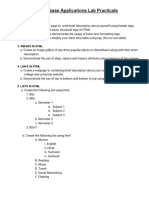Learn C - Introduction - Learn C - Introduction Cheatsheet - Codecademy
Uploaded by
Himanshu AgrawalLearn C - Introduction - Learn C - Introduction Cheatsheet - Codecademy
Uploaded by
Himanshu AgrawalCheatsheets / Learn C: Introduction
Learn C: Introduction
Syntax in C
The rules that dictate the correct format of code for a // Statements must end in a semicolon (;)
specific programming language are known as syntax.
// correct
Examples of syntax in C are:
All statements must end with a semicolon, ; printf("Hello World!");
Keywords and other code elements are case-
sensitive
// error
When compiling C code, an error will occur when the
syntax of the code is incorrect. printf("Hello World!")
// Code elements are case sensitive
// correct
printf("Hello World!");
// error
PRINTF("Hello World!");
Escape Sequences
In C, an escape sequence is a non-visual character // \n acts as a newline in a string
used within a string.
printf("Hello\nWorld!"); // Outputs:
\n is an escape sequence that adds a newline to a
string. \t is an escape sequence that adds a tab of Hello
spaces to a string. //
World!
// \t acts as a tab in a string
printf("Hello\tWorld!"); // Outputs:
Hello World!
Comments in C
In C, comments are text within code that will be ignored // Comments
by the compiler. They are used to document code.
Line comments begin with a double forward slash, // .
All text after // will be part of the comment until a new /* This review content is
line is reached. about comments and how they
Block comments begin with a forward slash and
can be used to document code */
asterisk, /* and end with an asterisk and forward slash,
*/ . Block comments can span multiple lines as new
lines are part of the comment. // This is a line comment
/* This is a
block comment */
Compiling C Code with gcc
gcc is an application used to compile C programs into gcc script.c
an executable that can run on the target computer.
gcc script.c -o myProgram
gcc stands for GNU Compiler Collection.
gcc compiles C code using the code file as an
unflagged command-line argument. The output
executable file will be called a.out . The -o flag
followed by some text can be used to designate the
name of the output executable file.
Print Share
You might also like
- Introduction To C Programming: "Turbo C Programming For PC", Robert Lafore, SAMS100% (2)Introduction To C Programming: "Turbo C Programming For PC", Robert Lafore, SAMS30 pages
- Introduction: Learn C: Introduction CheatsheetNo ratings yetIntroduction: Learn C: Introduction Cheatsheet2 pages
- Learn C - Hello World Cheatsheet - CodecademyNo ratings yetLearn C - Hello World Cheatsheet - Codecademy2 pages
- C Programming Logic and Design Module Part 1No ratings yetC Programming Logic and Design Module Part 114 pages
- Computational Skills Theory Notes All UnitsNo ratings yetComputational Skills Theory Notes All Units62 pages
- Technical Foundations of Computer Science III System Programming (C)No ratings yetTechnical Foundations of Computer Science III System Programming (C)18 pages
- CS101 Lecture 04 - Fundamentals of ProgrammingNo ratings yetCS101 Lecture 04 - Fundamentals of Programming28 pages
- Lesson 1-Introduction To Fundamentals of ProgrammingNo ratings yetLesson 1-Introduction To Fundamentals of Programming24 pages
- C Programming Language: - First SessionNo ratings yetC Programming Language: - First Session49 pages
- Computer Science HSSC-II Solution of 2nd Set Model Question PaperNo ratings yetComputer Science HSSC-II Solution of 2nd Set Model Question Paper13 pages
- Algorithm Implementation Source Code:: ProgramNo ratings yetAlgorithm Implementation Source Code:: Program5 pages
- Exploring Fiber - A High-Performance Web Framework For GolangNo ratings yetExploring Fiber - A High-Performance Web Framework For Golang3 pages
- DevsecOps Part 2 Post Quiz - Attempt ReviewNo ratings yetDevsecOps Part 2 Post Quiz - Attempt Review2 pages
- End of Course Memo CS 101 - Intro To Computing Aaron Bloomfield (Fall 2005)No ratings yetEnd of Course Memo CS 101 - Intro To Computing Aaron Bloomfield (Fall 2005)4 pages
- Generating SQL From LINQ Expression TreesNo ratings yetGenerating SQL From LINQ Expression Trees7 pages
- (eBook PDF) Building Java Programs: A Back to Basics Approach 5th Editionpdf download100% (4)(eBook PDF) Building Java Programs: A Back to Basics Approach 5th Editionpdf download56 pages
- Sample Paper - 2012 Class - XII Subject - Computer Science: InstructionsNo ratings yetSample Paper - 2012 Class - XII Subject - Computer Science: Instructions9 pages
- Fast and Parallel Algorithms For Multiple-Scattering ImagingNo ratings yetFast and Parallel Algorithms For Multiple-Scattering Imaging43 pages
- Hardware and Software Homework 3 Programming Language ClassificationNo ratings yetHardware and Software Homework 3 Programming Language Classification2 pages

























































































